42.
THE DECORATIVE ART OF THE INDIANS OF THE NORTH PACIFIC COAST1
ByFRANZn/aBOASn/an/an/an/a
It has been shown that the motives of the decorative art of many peoples developed largely from representations of animals. In course of time, forms that were originally realistic became more and more sketchy, and more and more distorted. Details, even large proportions, of the subject so represented were omitted, until finally the design attained a purely geometric character.
The decorative art of the Indians of the North Pacific Coast agrees with this oft-observed phenomenon in that its subjects are almost exclusively animals. It differs from other arts in that the process of conventionalizing has not led to the development of geometric designs, but that the parts of the animal body may still be recognized as such. The body of the animal, however, undergoes very fundamental changes in the arrangement and size of its parts. In the following paper I shall describe the characteristics of these changes, and discuss the mental attitude of the artist which led to their development.
In treating this subject, we must bear in mind that almost all the plastic art of the Indians of the North Pacific Coast is decorative art. While some primitive people—for instance, the Eskimo—produce carvings which serve no practical ends, but are purely works of art, all the works of the Indian artists of the region which we are considering serve at the same time a useful end; that is to say, the form of the object is given, and the subject to be represented is more or less subordinate to the object on which it is shown. Only in the cases of single totemic figures is the artist free to mould his subject without regard to such considerations; but, owing to the large size of such figures, he is limited by the cylindrical form of the trunk of the tree from which he carves his figures. We may therefore say that the native artist is in almost all his works limited by the shape of the object on which he represents his subject.
The plastic arts of the Indians are carving and painting, in which latter we may include tattooing and weaving. Carving is done mostly in wood, but also in stone and horn. It is either in the round, bas-relief, or, although more rarely, in high relief. There is no art of pottery.
The artists have acquired a high technique, which proves that realistic representations of animals are not beyond their powers. The following are a few exquisite examples of realistic carvings. The helmet (fig. 1) is decorated with the head of an old man affected with partial paralysis. Undoubtedly this specimen must be considered a portrait head. Nose, eyes, mouth, and the general expression, are highly characteristic. The mask (fig. 2) represents a dying warrior. The artist has represented faithfully the wide lower jaw, the pentagonal face, and the strong nose of the Indian. The relaxing muscles of the mouth and tongue, the drooping eyelids, the motionless eyeballs, mark the agonies of death. The conception is so realistic that the mask creates a ghastly impression. Figure 3 represents a dancing hat decorated with the design of a seal. Figure 4 is a small float representing a swimming puffin. Figure 5 is a rattle in the form of a swimming goose. The characteristic bend of its neck and the characteristic color of head and neck are very true to nature.
In these cases the artist has rendered the form of his model faithfully. The object on which the representation of his model was placed allowed him the use of the figure without any alteration. This is not often the case. Generally the object to be decorated has a certain given form to which the decoration must be subordinated, and the artist is confronted with the problem of how to adjust his subject to the form of the object to be decorated.
Before attempting an explanation of the method adopted by the artist in the solution of this problem, we must treat another aspect of our subject. We must premise that in consequence of the adaptation of the form to the decorative field, the native artist cannot attempt a realistic representation of his subject, but is often compelled to indicate only its main characteristics. In consequence of the distortion of the animal body, due to its adaptation to various surfaces, it would be all but impossible to recognize what animal is meant, if the artist did not emphasize what he considers the characteristic features of animals. These are so essential to his mind that he considers no representation adequate in which they are missing. In many cases they become the symbols of the animal. We find, therefore, that each animal is characterized by certain symbols, and great latitude is allowed in the treatment of all features other than symbols.
I will illustrate this feature of the art of the Indians of the North Pacific Coast by means of a number of characteristic examples.
Figure 6 is a figure from a totem pole, which represents the beaver. It will be noticed that the face is treated somewhat like a human face, particularly the region around eyes and nose. The position of the ears, however, indicates that the artist intended to represent an animal head,
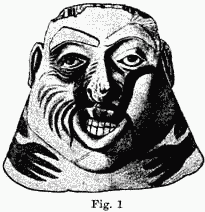 Fig. 1. Helmet with carving representing a paralytic man. Tribe, Tlingit. Height, 21.5 cm.; width, 28 cm.; depth, 28 cm.
Fig. 1. Helmet with carving representing a paralytic man. Tribe, Tlingit. Height, 21.5 cm.; width, 28 cm.; depth, 28 cm.
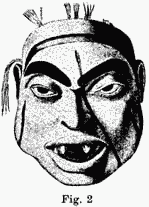 Fig. 2. Mask representing a dying warrior. Tribe, Tlingit. Height, 24 cm.; width, 19 cm.; depth, 11 cm.
Fig. 2. Mask representing a dying warrior. Tribe, Tlingit. Height, 24 cm.; width, 19 cm.; depth, 11 cm.
 Fig. 3. Dancing-hat representing a seal. Tribe, Tlingit. Height, 21 cm.; width, 24 cm.; depth, 23 cm.
Fig. 3. Dancing-hat representing a seal. Tribe, Tlingit. Height, 21 cm.; width, 24 cm.; depth, 23 cm.
 Fig. 4. Small float representing a swimming puffin. Tribe, Tlingit. Length, 6 cm.
Fig. 4. Small float representing a swimming puffin. Tribe, Tlingit. Length, 6 cm.
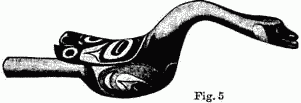 Fig. 5. Rattle representing a goose. Tribe, Haida. Length, 30 cm.
Fig. 5. Rattle representing a goose. Tribe, Haida. Length, 30 cm.
not a human head. While the human ear is represented, in its characteristic form, on a level with the eye, animal ears are indicated over the forehead; that is to say, approximately in the position in which they appear in a front view of the animal. Their characteristic shape may be seen in figures 6 and 7, and in many others. While the ears characterize the head as that of an animal, the two large incisors serve to identify the rodent par excellence—the beaver. The tail of the animal is turned
 Fig. 6. Lowest figure from model of a totem pole, carved in slate, representing a beaver. Tribe, Haida. Height, 22.5 cm.
Fig. 6. Lowest figure from model of a totem pole, carved in slate, representing a beaver. Tribe, Haida. Height, 22.5 cm.
 Fig. 7. Lowest figure from model of a totem pole, carved in slate, representing a beaver. Tribe, Haida. Height, 19 cm.
Fig. 7. Lowest figure from model of a totem pole, carved in slate, representing a beaver. Tribe, Haida. Height, 19 cm.
 Fig. 8. Handle of a spoon made of mountain-goat horn, design representing a beaver. Tribe, Tlingit. Length of handle, 8 cm.
Fig. 8. Handle of a spoon made of mountain-goat horn, design representing a beaver. Tribe, Tlingit. Length of handle, 8 cm.
up in front of its body. It is ornamented by cross-hatching, which is intended to represent the scales on the beaver’s tail. In its fore paws it holds a stick. The large incisors, the tail with cross-hatching, and the stick, are symbols of the beaver, and each of these is a sufficient characteristic of the animal.
Figure 7 is another representation of a beaver from a totem pole. It resembles figure 6 in all details, except that the stick is missing. The beaver is simply holding its fore paws raised nearly to its chin. There
are other carvings in which the beaver is shown with four or five toes, but the symbols described here never vary.
In figure 8, which is the handle of a spoon, we find only the first of the symbols of the beaver represented, namely, its incisors. Only the head and the fore paws of the animal are shown; and in its mouth are indicated an upper and a lower pair of incisors, all the other teeth being omitted. There is nothing except the teeth to indicate that the artist intended to represent the beaver.
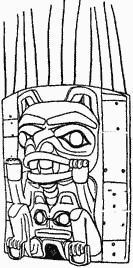 Fig. 9. Headdress representing a beaver. The dragon-fly is shown on the chest of the beaver. Tribe, Haida. Height, 18 cm.
Fig. 9. Headdress representing a beaver. The dragon-fly is shown on the chest of the beaver. Tribe, Haida. Height, 18 cm.
Figure 9 is the front of a dancing headdress, which is attached to a framework made of whalebone, and set on top with bristles of the sea-lion. To the back is attached a long train of ermine skins. The outer side of the carved front is set with abalone shells. The squatting figure which occupies the centre of the front represents the beaver. The same symbols which were mentioned before will be recognized here. The face is human; but the ears, which rise over the eyebrows, indicate that an animal is meant. Two large pairs of incisors occupy the centre of the open mouth. The tail is turned up in front of the body, and appears between the two hind legs, indicated by cross-hatching. The fore paws are raised to the height of the mouth, but they do not hold a stick. It will be noticed that on the chest of the beaver another head is represented,
over which a number of small rings stretch towards the chin of the beaver. Two feet, which belong to this animal, extend from the corners of its mouth towards the haunches of the beaver. This animal represents the dragon-fly, which is symbolized by a large head and a slender segmented body. In many representations of the dragon-fly there are two pairs of wings attached to the head. The face of this animal resembles also a human face; but the two ears, which rise over the eyebrows, indicate that an animal is meant. Combinations of two animals
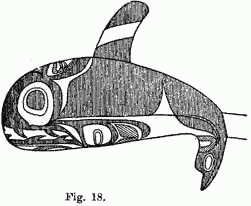 Fig. 18. Rattle representing a killer-whale. Tribe, Haida or Tsimshian. Length, 25 cm.
Fig. 18. Rattle representing a killer-whale. Tribe, Haida or Tsimshian. Length, 25 cm.
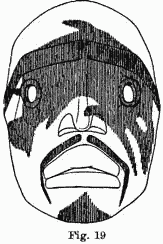 Fig. 19. Mask with painting representing a killer-whale. Tribe, Bella Coola. Height, 28 cm.; width, 20 cm.; depth, 15 cm.
Fig. 19. Mask with painting representing a killer-whale. Tribe, Bella Coola. Height, 28 cm.; width, 20 cm.; depth, 15 cm.
of this sort are found very frequently, a smaller figure of one animal being represented on the chest of a large carving. . . .
Figures 18 and 19 are representations of the killer-whale. In the rattle (fig. 18) the form of the whale will be easily recognized. Its tail is bent downward. The large head, one of the characteristic features of the whale, is much more pronounced in this than in the next figure. The eye appears on the front part of the rattle. Under the eye we see the large mouth, which is set with a number of curved spines. They are intended to represent the teeth. Immediately behind the mouth, on the lower part of the carving, we find the flippers. The painted ornament, which has the form of a small face, in front of the huge dorsal fin, is intended to represent the blow-hole. . . .
The following series (figures 21, 23) are representations of the shark. Whenever the whole body of this animal is represented, it is characterized by a heterocerc tail, a large mouth, the corners of which are drawn downward. A series of curved lines on each cheek which represent the gills, and a high tapering forehead, which is often decorated with two circles and a series of curved lines similar to those found on the cheeks. . . .
Figure 21 is the handle of a copper dagger on which the mouth with depressed corners, the curved lines on the cheeks, and the ornament rising over the forehead, characterize the shark. . . .
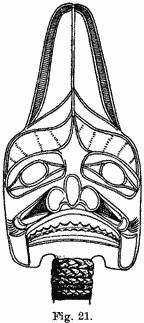 Fig. 21. Handle of a dagger, representing the head of a shark. Tribe, Tlingit. Length of shark figure, 13.5 cm.; width, 6.5 cm.
Fig. 21. Handle of a dagger, representing the head of a shark. Tribe, Tlingit. Length of shark figure, 13.5 cm.; width, 6.5 cm.
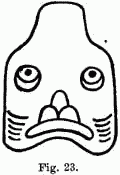 Fig. 23. Tattooing representing a shark. Tribe, Haida. (Drawn from a photograph.)
Fig. 23. Tattooing representing a shark. Tribe, Haida. (Drawn from a photograph.)
Figure 23 is a copy of a tattooing on the back of a Haida woman. Here we have only the outline of the head of a shark, again characterized by a peculiarly high forehead, the depressed corners of the mouth, and curved lines on each cheek. . . .
Let us briefly recapitulate what we have thus far tried to show. Animals are characterized by their symbols, and the following series of symbols have been described in the preceding remarks:
1. Of the beaver: large incisors, scaly tail, and a stick held in the fore paws.
2. Of the sculpin: two spines rising over the mouth, and a continuous dorsal fin.
 Fig. 25.—Model of a totem-pole with three figures, representing, from below upward, a sculpin, a dog-fish, and a sea-monster. Tribe, Haida. Height, 47.5 cm.
Fig. 25.—Model of a totem-pole with three figures, representing, from below upward, a sculpin, a dog-fish, and a sea-monster. Tribe, Haida. Height, 47.5 cm.
3. Of the hawk: large curved beak, the point of which is turned backward so that it touches the face.
4. Of the eagle: large curved beak, the point of which is turned downward.
5. Of the killer-whale: large head, large mouth set with teeth, blow-hole, and large dorsal fin.
6. Of the shark: an elongated rounded cone ris ing over the forehead, mouth with depressed corners. a series of curved lines on the cheeks, two circles and curved lines on the ornament rising over the forehead, round eyes, numerous sharp teeth, and heterocerc tail.
7. Of the bear: large paws, and large mouth set with teeth, with protruding tongue.
8. Of the sea-monster: bear’s head, bear’s paws with flippers attached, and gills and body of the killer-whale, with several dorsal fins.
9. Of the dragon-fly: large head, segmented, slender body, and wings.
So far I have considered the symbols only in connection with their use in representing various animals. It now becomes necessary to inquire in what manner they are used to identify the animals. We have seen that in a number of the preceding cases entire animals were represented, and that they were identified by means of these symbols. When we investigate this subject more closely, we find that the artist is allowed wide latitude in the selection of the form of the animal. Whatever the form may be, as long as the recognized symbols are present, the identity of the animal is established. We have mentioned before that the symbols are often applied to human faces, while the body of the figure has the characteristics of the animal.
We find this principle applied in figure 25, which represents a totem pole. Three animals are shown in this carving. Each of these has a human face, to which are added the symbols that characterize the animal. In the top figure the ears indicate that the head represents that of an animal; while the arms, to which the flippers are attached, indicate that the sea-monster is meant. The next figure below represents the shark. It is a human face, and it seems that originally a large lip with a labret was attached to it, which, however,
was lost before the specimen came into possession of the Museum. This would indicate that a female shark is represented. Its symbols in this case are the peculiar high ornament which rises over its forehead, and the fins, which are placed under the chin. The face of the lowest figure resembles the faces of the two upper figures very closely. Its body, which is shown under the face, makes it clear that the artist intended to represent a fish; and the two large spines which rise over the eyebrows specify that the figure represents a sculpin. . . .
These symbols are also used as facial paintings by dancers, who are thus recognized as personifying the animal in question, or as belonging to the social group presided over by the animal. At social or religious festivals ceremonies are performed which are in most cases dramatizations of myths, in which the dancer represents either the animal, or the spirit that appeared to his ancestor. In many of the composite masks used on such occasions, the ancestor himself is represented by a small figure placed on the mask, thus indicating that he was carried away by the animal which the dancer personifies. In other festivals, legends are dramatized which refer to the events that took place "before the animals took off their blankets"; that is, at the time when there was no clear distinction between men and animals. In these ceremonies the dancers appear with paintings or other decoration symbolizing the animals. To this class belongs the ornament (figure 30), which represents the dorsal fin of a killer-whale, and which is worn attached to the back part of the blanket. These ornaments and paintings are found most extensively among the Kwakiutl tribes.
It appears, therefore, that as, first of all, the artist tried to characterize the animals he intended to represent by emphasizing their most prominent characteristics, these gradually became symbols which were recognized even when not attached to the animal form, and which took the place of representations of the entire animal.
Having thus become acquainted with a few of the symbols of animals, we will next investigate in what manner the native artist adapted the animal form to the object he intended to decorate. First of all, we will direct our attention to a series of specimens which show that the native artist endeavors, whenever possible, to represent the whole animal on the object that he desires to decorate.
Figure 31 is a club used for killing seals and halibut before they are landed in the canoe. The carving represents the killer-whale. If the principal symbol of the killer-whale, its dorsal fin, were placed in an upright position on the club, the implement would assume an exceedingly awkward shape. On the other hand, the artist could not omit the dorsal fin, since it is the most important symbol of the animal. Therefore he has bent it downward along the side of the body, so that it covers the flipper.
The tail of the whale would have interfered with the handle, and for this reason it has been turned forward over the back of the whale, so as to be in close contact with the body.
The distortion of the body has been carried still further in figure 32, which is the handle of a spoon, and represents the same animal. The large
 Fig. 31. Fish-club carved to represent the killer-whale. Tribe, Tlingit. Total length, 49 cm.; height, 8 cm.; thickness, 5 cm.
Fig. 31. Fish-club carved to represent the killer-whale. Tribe, Tlingit. Total length, 49 cm.; height, 8 cm.; thickness, 5 cm.
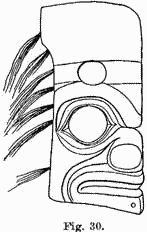 Fig. 30. Wood-carving representing the dorsal fin of a killer-whale. Tribe, Tlingit. Height, 25 cm.; thickness, 3 cm.
Fig. 30. Wood-carving representing the dorsal fin of a killer-whale. Tribe, Tlingit. Height, 25 cm.; thickness, 3 cm.
 Fig. 32. Handle of horn spoon with design representing a killer-whale. Tribe, probably Tsimshian. Length of handle, 15 cm.
Fig. 32. Handle of horn spoon with design representing a killer-whale. Tribe, probably Tsimshian. Length of handle, 15 cm.
head of the whale, to which the flippers are attached, will be easily recognized near the bowl of the spoon. The body has been twisted backward so that the tail almost touches the mouth. The carving is only on the back of the spoon, and the two projections just below the mouth
will be recognized as the two tips of the whale’s tail, which has been split along its lower side and then distended along the back of the spoon. The dorsal fin has thus been brought into a position so as to extend along the handle of the spoon. It is seen projecting upward from the head of the whale, between the legs of the mail who forms the tip of the handle. . . .
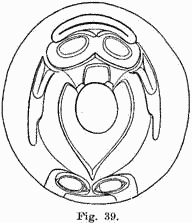 Fig. 39. Dancing-hat with design representing a sculpin. Tribe, Haida or Tsimshian. Height, 14 cm.; width, 36 cm.; depth, 40 cm.
Fig. 39. Dancing-hat with design representing a sculpin. Tribe, Haida or Tsimshian. Height, 14 cm.; width, 36 cm.; depth, 40 cm.
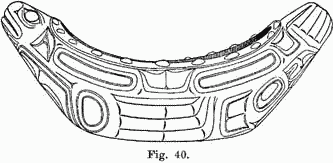 Fig. 40. Grease-dish in the shape of a seal. Tribe, Tlingit. Length, 41.5 cm.; width, 21 cm.; depth in center, 9.5 cm.
Fig. 40. Grease-dish in the shape of a seal. Tribe, Tlingit. Length, 41.5 cm.; width, 21 cm.; depth in center, 9.5 cm.
We have now to treat a series of peculiar phenomena which result from the endeavor on the part of the artist to adjust the animal that he desires to represent to the decorative field in such a manner as to preserve as far as possible the whole animal, and bring out its symbols most clearly.
Figure 39 is the top view of a wooden hat on which is carved the figure of a sculpin. The animal is shown in top view, as though it were lying with its lower side on the hat. The dancing hats of these Indians have the forms of truncated cones. To the top are attached a series of rings, mostly made of basketry, which indicate the social rank of the owner, each ring symbolizing a step in the social ladder. The top of the hat, therefore, does not belong to the decorative field, which is confined to the surface of the cone. The artist found it necessary, therefore, to open the back of the sculpin far enough to make room for the gap in the decorative field. He has done so by representing the animal as seen from the top, but split and distended in the middle, so that the top of the hat is located in the opening thus secured.
Figure 40 represents a dish in the shape of a seal. The whole dish is carved in the form of the animal; but the bottom, which corresponds to the belly, is flattened, and the back is hollowed out so as to form the bowl of the dish. In order to gain a wider rim the whole back has been distended so that the animal becomes inordinately wide as compared to its length. The flippers are carved in their proper positions at the sides of the dish. The hind flippers are turned back, and closely join the tail. A similar method of representation is used in decorating small boxes. The whole box is considered as representing an animal. The front of its body is painted or carved on the box front; its sides, on the sides of the box; the hind side of its body, on the back of the box. The bottom of the box is the animal’s stomach; the top, or the open upper side, its back. These boxes, therefore, are decorated only on the sides, which are bent of a single piece of wood (fig. 41). When we unbend the sides we find the decoration extended on a long band, which we may consider as consisting of two symmetrical halves. The centre is occupied by the front view of the animal, the sides by a side view, and the ends by one-half of the hind view at each end of the board. An actual unbending of the sides of the box would not give a symmetrical form; but, since the ends are necessarily sewed at the corner, the hind view of the body will occupy one end.
In the decoration of silver bracelets a similar principle is followed, but the problem differs somewhat from that offered in the decoration of square boxes. While in the latter case the four edges make a natural division between the four views of the animal—front and right profile, back and left profile—there is no such sharp line of division in the round bracelet, and there would be great difficulty in joining the four aspects artistically, while two profiles offer no such difficulty. When the tail end of each profile is placed where the ends of the bracelet join, then there is only one point of junction; namely, in the median line of the head. This is the method of representation that the native artists have adopted
(fig. 42). The animal is cut in two from head to tail, so that the two halves cohere only at the tip of the nose and at the tip of the tail. The hand is put through this hole, and the animal now surrounds the wrist. In this position it is represented on the bracelet. The method adopted is therefore identical with the one applied in the hat (fig. 39), except that the central opening is much larger, and that the animal has been represented on a cylindrical surface, not a conical one.
 Fig. 41. Carving on the sides of a dish, representing a beaver. The sides of the dish are bent of a single piece of wood, and are shown here flattened out. Tribe, Tlingit. Length of short sides, 29 cm.; length of long sides, 31.5 cm.; greatest height of sides, 16 cm.
Fig. 41. Carving on the sides of a dish, representing a beaver. The sides of the dish are bent of a single piece of wood, and are shown here flattened out. Tribe, Tlingit. Length of short sides, 29 cm.; length of long sides, 31.5 cm.; greatest height of sides, 16 cm.
 Fig. 42. Design on a bracelet representing a bear. Tribe, Nass River Indians. Height, 3.5 cm.
Fig. 42. Design on a bracelet representing a bear. Tribe, Nass River Indians. Height, 3.5 cm.
An examination of the head of the bear shown on the bracelet (fig. 42), makes it clear that this idea has been carried out rigidly. It will be noticed that there is a deep depression between the eyes, extending down to the nose. This shows that the head itself must not be considered a front view, but as consisting of two profiles which adjoin at mouth and nose, while they are not in contact with each other on a level with the eyes and forehead. The peculiar ornament rising over the nose of the bear decorated with three rings, represents a hat with three rings, which designate the rank of the bearer. . . .
The transition from the bracelet to the painting or carving of animals on a flat surface is not a difficult one. The same principle is adhered to; and either the animals are represented as split in two so that the profiles
are joined in the middle, or a front view of the head is shown with two adjoining profiles of the body. In the cases considered heretofore the animal was cut through and through from the mouth to the tip of the tail. These points were allowed to cohere, and the animal was stretched over a ring, a cone, or the sides of a prism. If we imagine the bracelet opened, and flattened in the manner in which it is shown in figure 42, we have a section of the animal from mouth to tail, cohering only at the mouth, and the two halves spread over a flat surface. This is the natural development of the method here described when applied to the decoration of flat surfaces.
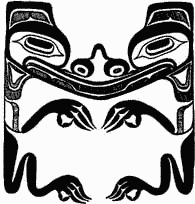 Fig. 43. Painting representing a bear. Tribe, Haida.
Fig. 43. Painting representing a bear. Tribe, Haida.
It is clear that on flat surfaces this method allows of modifications by changing the method of cutting. When the body of a long animal, such as that of a fish or of a standing quadruped, is cut in this manner, a design results which forms a long narrow strip. This mode of cutting is therefore mostly applied in the decoration of long bands. When the field that is to be decorated is more nearly square, this form is not favorable. In such cases a square design is obtained by cutting quadrupeds sitting on their haunches in the same manner as before, and unfolding the animal so that the two halves remain in contact at the nose and mouth, while the median line at the back is to the extreme right and to the extreme left.
Figure 43 (a Haida painting) shows a design which has been obtained in this manner. It represents a bear. The enormous breadth of mouth observed in these cases is brought about by the junction of the two profiles of which the head consists.
This cutting of the head is brought out most clearly in the painting (fig. 44), which also represents the bear. It is the painting on the front of a Tsimshian house, the circular hole in the middle of the design being the door of the house. The animal is cut from back to front, so that only the front part of the head coheres. The two halves of the lower jaw do not touch each other. The back is represented by the black outline oil which the hair is indicated by fine lines.
 Fig. 44. Painting from a house-front, representing a bear. Tribe, Tsimshian.
Fig. 44. Painting from a house-front, representing a bear. Tribe, Tsimshian.
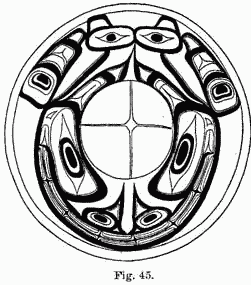 Fig. 45. Wooden hat painted with the design of a sculpin. Tribe, Haida. Height, 17 cm.; width, 41 cm.; depth, 42.5 cm.
Fig. 45. Wooden hat painted with the design of a sculpin. Tribe, Haida. Height, 17 cm.; width, 41 cm.; depth, 42.5 cm.
In a number of cases the designs painted on hats must also be explained as formed by the junction of two profiles. This is the case in the painted wooden hat (fig. 45), on which the design of a sculpin is shown. It will be noticed that only the mouth of the animal coheres, while the eyes are widely separated. The spines rise immediately over the mouth. The flippers are attached to the corners of the face, while the dorsal fin is split into halves, each half being joined to an eye.
The beaver (fig. 46) has been treated in the same manner. The head is split down to the mouth, over which rises the hat with four rings. The split has been carried back to the tail, which, however, is left intact, and turned up towards the centre of the hat. The importance of the symbols
becomes very clear in this specimen. If the two large black teeth which are seen under the four rings, and the tail with the cross-hatchings, were omitted, the figure would represent the frog. . . .
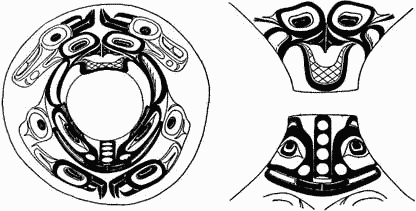 Fig. 46. Hat made of spruce root, painted with the design of a beaver. Tribe, Haida or Tsimshian. Height, 16 cm.; diameter, 36.5 cm.
Fig. 46. Hat made of spruce root, painted with the design of a beaver. Tribe, Haida or Tsimshian. Height, 16 cm.; diameter, 36.5 cm.
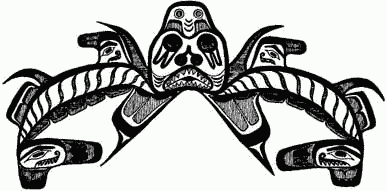 Fig. 53. Painting representing a shark. Tribe, Haida.
Fig. 53. Painting representing a shark. Tribe, Haida.
In the following figures we find a new cut applied. Figure 53. . . . represents the shark. I explained, when discussing the symbols of the shark, that in the front view of the animal the symbols are shown to best
advantage. For this reason side views of the face of the shark are avoided, and in representing the whole animal a cut is made from the back to the lower side, and the two sides are unfolded, leaving the head in front view.
The painting (fig. 53) has been made in this manner, the two halves of the body being entirely separated from each other, and folded to the right and to the left. The heterocerc tail is cut in halves, and is shown at
each end turned downward. The pectoral fins are shown unduly enlarged, in order to fill the vacant space under the head. . . .
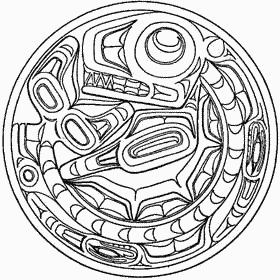 Fig. 62. Slate dish with design representing a killer-whale. Tribe, Haida. Diameter, 41.5 cm.; depth, 6.5 cm.
Fig. 62. Slate dish with design representing a killer-whale. Tribe, Haida. Diameter, 41.5 cm.; depth, 6.5 cm.
In figure 62, which represents the design on a circular slate dish, we see a good case of the adaptation of a profile to the decorative field. The design represents a killer-whale with two dorsal fins. The animal is bent around the rim of a dish so that the head touches the tail. The two dorsal fins are laid flat along the back, while the large flipper occupies the center of the dish. . . .
I have described a number of sections applied in representing various animals. Heretofore, we have had cases only in Which the sections were rather simple. In many cases in which the adaptation of the animal form to the decorative field is more difficult, the sections and distortions are much more numerous and far-reaching than those described before.
The cut that has been applied in the totem pole (fig. 66) is also much more intricate than the preceding ones. The upper figure represents a bird which is shown in the form of a human being, to the arms of which wings are attached. Under this figure we find a representation of the killer-whale. The hind part of its body is more easily recognized than the head. A small human figure is seen riding on the dorsal fin. The tail, which appears at the lower margin of the figure, is turned backward over the back of the animal. We must therefore imagine that the head has been turned downward behind the human figure riding on the dorsal fin. We must remember that the part of the animal which is turned downward will be placed in the back of the totem pole, which is not carved, and that consequently, according to what was stated before, the artist will split it and distend it so that the middle line will appear at each edge of the carved portion of the pole. Thus the right half of the head will be brought into view on the right side of the totem pole, the left half on the left. This is the explanation of the whale’s head with its teeth, which is seen in our figure next to the tail, the lower jaw being omitted. The flipper, which adjoins the head, is laid over the back of the whale, immediately under the feet of the human being riding on the dorsal fin of the whale. The figure must therefore be explained in such a way that the animal is twisted twice, the tail being turned over the back, and the head being turned down under the stomach, the head being then split and extended outward. . . .
 Fig. 66. Part of model of a totem pole, with design representing a killer-whale. Tribe, Haida. Height, from whale upward, 35 cm.; width, 8 cm.; depth, 6.5 cm.
Fig. 66. Part of model of a totem pole, with design representing a killer-whale. Tribe, Haida. Height, from whale upward, 35 cm.; width, 8 cm.; depth, 6.5 cm.
We can now sum up the results of our considerations. In the first part of this paper I described the symbols of a number of animals, and pointed out that in many cases there is a tendency to substitute the symbol for the whole animal. The works of art which I described in the second part of my paper may be said to illustrate a principle which is apparently diametrically opposed to the former. While the symbolism developed a tendency to suppress parts of the animal, we find in the efforts of the artist to
adapt the form of the animal to the decorative field a far-reaching desire to preserve, so far as feasible, the whole animal; and, with the exception of a few profiles, we do not find a single instance which can be interpreted as an endeavor to give a perspective and therefore realistic view of an animal. We have found a variety of methods applied which tend to bring the greatest possible part of the animal form into the decorative field. I conclude from this that it is the ideal of the native artist to show the whole animal, and that the idea of perspective representation is entirely foreign to his mind. His representations are combinations of symbols of the various parts of the body of the animal, arranged in such a way that if possible the whole animal is brought into view. The arrangement, however, is so that the natural relation of the parts is preserved, being changed only by means of sections and distortions, but so that the natural contiguity of the parts is preserved.
The success of the artist depends upon his cleverness in designing lines of dissection and methods of distortion. When he finds it impossible to represent the whole animal, he confines himself to rearranging its most characteristic parts, always of course including its symbols. There is a tendency to exaggerate the size of the symbols at the expense of other parts of the subject. I presume this is the line in which the two principles of the decorative art of the Indians of the North Pacific Coast of America merge into each other. The gradual emphasizing of the symbol at the expense of other parts of the body leads in many cases to their entire suppression, and to designs in which the animal is indicated only by its symbols.
1